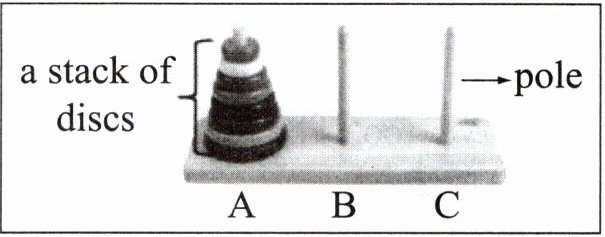五、阅读理解
On February 22, Guo Hongyi, an 8 - year - old boy, solved a 4 - level Tower of Hanoi with one hand in 4.305 seconds and set a new world record.

Tower of Hanoi is a Maths game which has been popular for centuries. To solve a Tower of Hanoi puzzle, it needs your brain, eyes and hands to work together.
Tower of Hanoi is made up of three poles and a stack of discs. The discs should be placed from the largest on the bottom to the smallest on the top. The way to play the game is to move the whole stack from Pole A to Pole C. There are three simple rules as follows:
◆Only one disc can be moved at a time.
◆You can only move the top disc of a stack.
◆Each disc can be placed on any pole, but it can't be placed on top of a smaller disc.
Tower of Hanoi was invented by a French mathematician called Edouard Lucas in 1883. His idea came from an ancient story: In an Eastern temple (寺庙) with three huge poles, the god asked the priests (僧侣) to move a stack of 64 golden discs from Pole One to Pole Three. Edouard found the Maths problem in the story interesting and tried to work out the minimum (最小的) number of moves to solve the puzzle. Finally, he came up with the formula: $2^{n}-1$, where "n" is the number of discs. According to the formula, even if the priests made one move every second, it would take 500 billion years to finish. It was an impossible task for them.
Nowadays, Tower of Hanoi is used in many fields, such as the psychological research and computer science. It has made great contributions to humans' life.
So next time you're looking for a fun and challenging puzzle game, give Tower of Hanoi a try!
(
D
) 1. According to the rules of Tower of Hanoi, which of the following pictures shows the correct move?

(
A
) 2. The formula created by Edouard is used to know the ______.
A. fewest moves
B. sizes of discs
C. fewest discs
D. speed of moves
(
C
) 3. Why does the writer write the passage?
A. To show how popular Tower of Hanoi is.
B. To introduce the history of Tower of Hanoi.
C. To attract (吸引) more people to play Tower of Hanoi.
D. To explain why Tower of Hanoi is widely used.